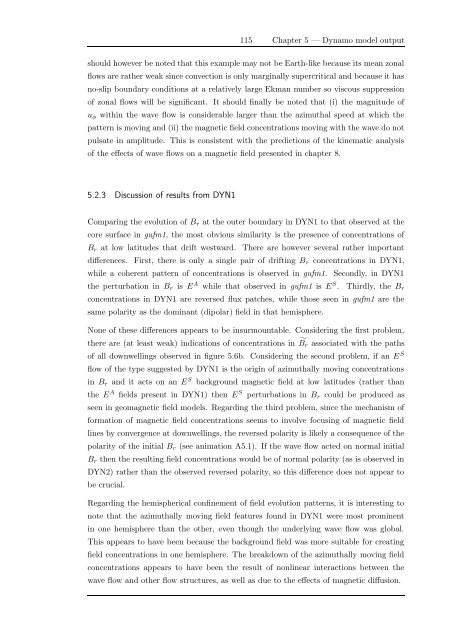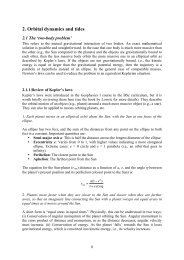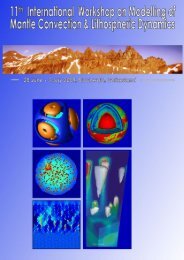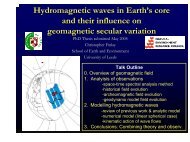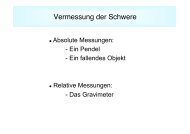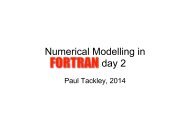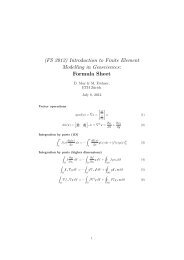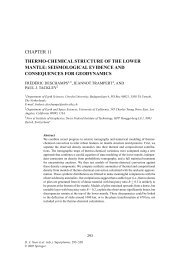Hydromagnetic waves in Earth's core and their influence on ...
Hydromagnetic waves in Earth's core and their influence on ...
Hydromagnetic waves in Earth's core and their influence on ...
You also want an ePaper? Increase the reach of your titles
YUMPU automatically turns print PDFs into web optimized ePapers that Google loves.
115 Chapter 5 — Dynamo model outputshould however be noted that this example may not be Earth-like because its mean z<strong>on</strong>alflows are rather weak s<str<strong>on</strong>g>in</str<strong>on</strong>g>ce c<strong>on</strong>vecti<strong>on</strong> is <strong>on</strong>ly marg<str<strong>on</strong>g>in</str<strong>on</strong>g>ally supercritical <str<strong>on</strong>g>and</str<strong>on</strong>g> because it hasno-slip boundary c<strong>on</strong>diti<strong>on</strong>s at a relatively large Ekman number so viscous suppressi<strong>on</strong>of z<strong>on</strong>al flows will be significant. It should f<str<strong>on</strong>g>in</str<strong>on</strong>g>ally be noted that (i) the magnitude ofu φ with<str<strong>on</strong>g>in</str<strong>on</strong>g> the wave flow is c<strong>on</strong>siderable larger than the azimuthal speed at which thepattern is mov<str<strong>on</strong>g>in</str<strong>on</strong>g>g <str<strong>on</strong>g>and</str<strong>on</strong>g> (ii) the magnetic field c<strong>on</strong>centrati<strong>on</strong>s mov<str<strong>on</strong>g>in</str<strong>on</strong>g>g with the wave do notpulsate <str<strong>on</strong>g>in</str<strong>on</strong>g> amplitude. This is c<strong>on</strong>sistent with the predicti<strong>on</strong>s of the k<str<strong>on</strong>g>in</str<strong>on</strong>g>ematic analysisof the effects of wave flows <strong>on</strong> a magnetic field presented <str<strong>on</strong>g>in</str<strong>on</strong>g> chapter 8.5.2.3 Discussi<strong>on</strong> of results from DYN1Compar<str<strong>on</strong>g>in</str<strong>on</strong>g>g the evoluti<strong>on</strong> of B r at the outer boundary <str<strong>on</strong>g>in</str<strong>on</strong>g> DYN1 to that observed at the<str<strong>on</strong>g>core</str<strong>on</strong>g> surface <str<strong>on</strong>g>in</str<strong>on</strong>g> gufm1, the most obvious similarity is the presence of c<strong>on</strong>centrati<strong>on</strong>s ofB r at low latitudes that drift westward. There are however several rather importantdifferences. First, there is <strong>on</strong>ly a s<str<strong>on</strong>g>in</str<strong>on</strong>g>gle pair of drift<str<strong>on</strong>g>in</str<strong>on</strong>g>g B r c<strong>on</strong>centrati<strong>on</strong>s <str<strong>on</strong>g>in</str<strong>on</strong>g> DYN1,while a coherent pattern of c<strong>on</strong>centrati<strong>on</strong>s is observed <str<strong>on</strong>g>in</str<strong>on</strong>g> gufm1. Sec<strong>on</strong>dly, <str<strong>on</strong>g>in</str<strong>on</strong>g> DYN1the perturbati<strong>on</strong> <str<strong>on</strong>g>in</str<strong>on</strong>g> B r is E A while that observed <str<strong>on</strong>g>in</str<strong>on</strong>g> gufm1 is E S . Thirdly, the B rc<strong>on</strong>centrati<strong>on</strong>s <str<strong>on</strong>g>in</str<strong>on</strong>g> DYN1 are reversed flux patches, while those seen <str<strong>on</strong>g>in</str<strong>on</strong>g> gufm1 are thesame polarity as the dom<str<strong>on</strong>g>in</str<strong>on</strong>g>ant (dipolar) field <str<strong>on</strong>g>in</str<strong>on</strong>g> that hemisphere.N<strong>on</strong>e of these differences appears to be <str<strong>on</strong>g>in</str<strong>on</strong>g>surmountable. C<strong>on</strong>sider<str<strong>on</strong>g>in</str<strong>on</strong>g>g the first problem,there are (at least weak) <str<strong>on</strong>g>in</str<strong>on</strong>g>dicati<strong>on</strong>s of c<strong>on</strong>centrati<strong>on</strong>s <str<strong>on</strong>g>in</str<strong>on</strong>g> ˜B r associated with the pathsof all downwell<str<strong>on</strong>g>in</str<strong>on</strong>g>gs observed <str<strong>on</strong>g>in</str<strong>on</strong>g> figure 5.6b. C<strong>on</strong>sider<str<strong>on</strong>g>in</str<strong>on</strong>g>g the sec<strong>on</strong>d problem, if an E Sflow of the type suggested by DYN1 is the orig<str<strong>on</strong>g>in</str<strong>on</strong>g> of azimuthally mov<str<strong>on</strong>g>in</str<strong>on</strong>g>g c<strong>on</strong>centrati<strong>on</strong>s<str<strong>on</strong>g>in</str<strong>on</strong>g> B r <str<strong>on</strong>g>and</str<strong>on</strong>g> it acts <strong>on</strong> an E S background magnetic field at low latitudes (rather thanthe E A fields present <str<strong>on</strong>g>in</str<strong>on</strong>g> DYN1) then E S perturbati<strong>on</strong>s <str<strong>on</strong>g>in</str<strong>on</strong>g> B r could be produced asseen <str<strong>on</strong>g>in</str<strong>on</strong>g> geomagnetic field models. Regard<str<strong>on</strong>g>in</str<strong>on</strong>g>g the third problem, s<str<strong>on</strong>g>in</str<strong>on</strong>g>ce the mechanism offormati<strong>on</strong> of magnetic field c<strong>on</strong>centrati<strong>on</strong>s seems to <str<strong>on</strong>g>in</str<strong>on</strong>g>volve focus<str<strong>on</strong>g>in</str<strong>on</strong>g>g of magnetic fieldl<str<strong>on</strong>g>in</str<strong>on</strong>g>es by c<strong>on</strong>vergence at downwell<str<strong>on</strong>g>in</str<strong>on</strong>g>gs, the reversed polarity is likely a c<strong>on</strong>sequence of thepolarity of the <str<strong>on</strong>g>in</str<strong>on</strong>g>itial B r (see animati<strong>on</strong> A5.1). If the wave flow acted <strong>on</strong> normal <str<strong>on</strong>g>in</str<strong>on</strong>g>itialB r then the result<str<strong>on</strong>g>in</str<strong>on</strong>g>g field c<strong>on</strong>centrati<strong>on</strong>s would be of normal polarity (as is observed <str<strong>on</strong>g>in</str<strong>on</strong>g>DYN2) rather than the observed reversed polarity, so this difference does not appear tobe crucial.Regard<str<strong>on</strong>g>in</str<strong>on</strong>g>g the hemispherical c<strong>on</strong>f<str<strong>on</strong>g>in</str<strong>on</strong>g>ement of field evoluti<strong>on</strong> patterns, it is <str<strong>on</strong>g>in</str<strong>on</strong>g>terest<str<strong>on</strong>g>in</str<strong>on</strong>g>g t<strong>on</strong>ote that the azimuthally mov<str<strong>on</strong>g>in</str<strong>on</strong>g>g field features found <str<strong>on</strong>g>in</str<strong>on</strong>g> DYN1 were most prom<str<strong>on</strong>g>in</str<strong>on</strong>g>ent<str<strong>on</strong>g>in</str<strong>on</strong>g> <strong>on</strong>e hemisphere than the other, even though the underly<str<strong>on</strong>g>in</str<strong>on</strong>g>g wave flow was global.This appears to have been because the background field was more suitable for creat<str<strong>on</strong>g>in</str<strong>on</strong>g>gfield c<strong>on</strong>centrati<strong>on</strong>s <str<strong>on</strong>g>in</str<strong>on</strong>g> <strong>on</strong>e hemisphere. The breakdown of the azimuthally mov<str<strong>on</strong>g>in</str<strong>on</strong>g>g fieldc<strong>on</strong>centrati<strong>on</strong>s appears to have been the result of n<strong>on</strong>l<str<strong>on</strong>g>in</str<strong>on</strong>g>ear <str<strong>on</strong>g>in</str<strong>on</strong>g>teracti<strong>on</strong>s between thewave flow <str<strong>on</strong>g>and</str<strong>on</strong>g> other flow structures, as well as due to the effects of magnetic diffusi<strong>on</strong>.


